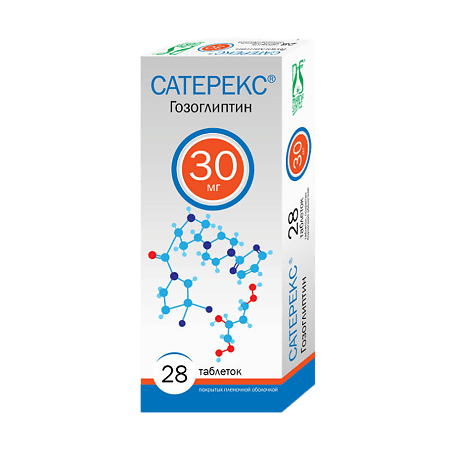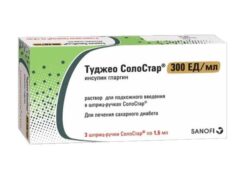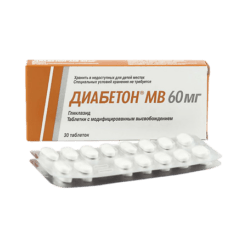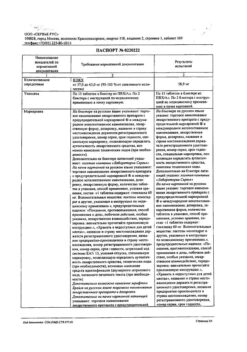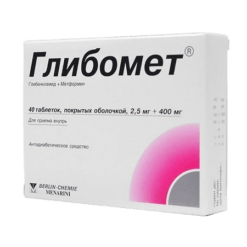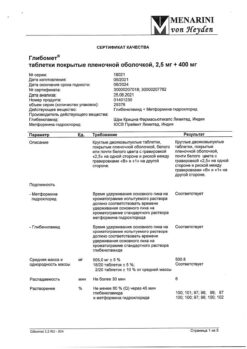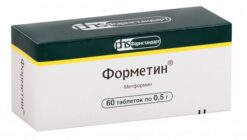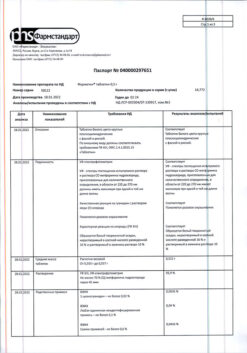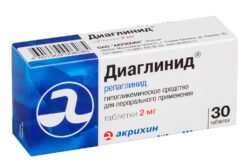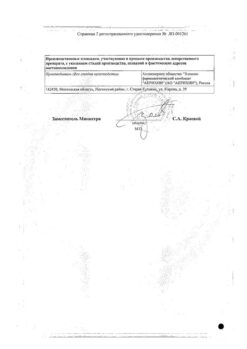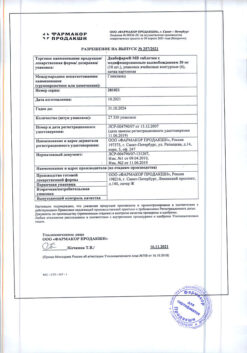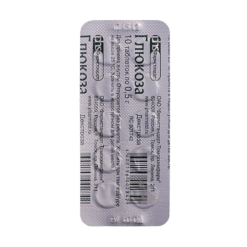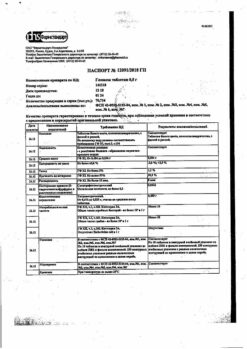No products in the cart.
Saterex, 30 mg 28 pcs.
€31.71 €26.43
Description
Gozogliptin is an active, highly selective inhibitor of the dipeptidyl peptidase-4 (DPP-4) enzyme for the treatment of type 2 diabetes.
Indications
Indications
The drug Saterex® is indicated for use in adult patients over 18 years of age for the treatment of type 2 diabetes mellitus (in combination with diet therapy and exercise):
as monotherapy in case of ineffectiveness of diet therapy and exercise in patients with a contraindication to the use of metformin;
in combination with metformin as initial therapy, or when diet and exercise in combination with metformin monotherapy or gosogliptin monotherapy do not lead to adequate glycemic control; 4
to improve glycemic control in combination with sulfonylureas, when diet and exercise in combination with sulfonylurea monotherapy do not lead to adequate glycemic control;
as an adjunct to insulin (with or without metformin) in cases where diet, exercise and a stable dose of insulin do not lead to adequate glycemic control.
Pharmacological effect
Pharmacological effect
Pharmacotherapeutic group: hypoglycemic agent – dipeptidyl peptidase 4 inhibitor
ATX code: A10BH
Pharmacological properties
Pharmacodynamics Gosogliptin is an active, highly selective inhibitor of the enzyme dipeptidyl peptidase-4 (DPP-4), intended for the treatment of type 2 diabetes mellitus. By inhibiting the activity of DPP-4, gosogliptin increases the concentration of incretin family hormones synthesized in the intestine: glucagon-like peptide-1 (GLP-1) and glucose-dependent insulinotropic polypeptide (GIP). An increase in the concentration of GLP-1 and GIP causes an increase in the sensitivity of pancreatic beta cells to glucose, which leads to an increase in the synthesis and secretion of insulin. Increasing the concentration of GLP-1 causes an increase in the sensitivity of pancreatic alpha cells to glucose, which leads to improved glucose-dependent regulation of glucagon secretion. Reducing the increased secretion of glucagon during meals causes a decrease in insulin resistance. A decrease in glucagon concentration against the background of an increase in insulin concentration, caused by an increase in the concentration of GLP-1 and GIP, causes a decrease in glucose production by the liver, which leads to a decrease in blood glucose levels. In patients with type 2 diabetes mellitus with hyperglycemia, these changes in insulin and glucagon secretion lead to a decrease in the concentration of glycated hemoglobin HbA1c and a decrease in the concentration of glucose in blood plasma both on an empty stomach and after a meal. When gozogliptin was used in more than 750 patients with type 2 diabetes mellitus for 12 to 36 weeks as monotherapy or in combination with metformin, there was a significant long-term decrease in the concentration of HbA1c, fasting blood glucose and 2 hours after meals. No significant changes in body weight were observed during treatment with gosogliptin; the frequency of hypoglycemic episodes was minimal.
Pharmacokinetics
Absorption The pharmacokinetics of gozogliptin are similar in healthy individuals and in patients with type 2 diabetes mellitus. Gosogliptin is rapidly absorbed when taken orally with an absolute bioavailability of more than 99%. The maximum concentration (Cmax) in blood plasma is achieved within 1 hour after administration. Average plasma concentrations increase in proportion to the dose. The decrease in the concentration of gosogliptin in the blood plasma after reaching Cmax is biphasic. After taking gozogliptin at a dosage of 30 mg, the area under the concentration-time curve (AUC) averages 4800-5200 ng*h/ml, the coefficient of individual variability of AUC is 11.5-27.2%.
Eating increases the rate of absorption for up to 2 hours, but does not significantly affect the extent of absorption and the area under the concentration-time curve (AUC). The combined use of gozogliptin with metformin does not affect the dynamics of their absorption. Distribution The degree of binding of gosogliptin to plasma proteins is 11.5%. 3 Metabolism The main metabolic pathway of gosogliptin in humans is associated with hydroxylation of the pyrimidine group. Other metabolites are associated with amide hydrolysis, carabamoyl glucuronidation, formamide conjugation, glucose conjugation, and creatinine conjugation. In vitro studies using human liver microsomal enzymes showed low binding constants and inhibition of cytochromes CYP1A2, 2C9, 2C19, 2D6 and 3A4 by gosogliptin. Excretion Gosogliptin is excreted from the body primarily by the kidneys. After oral administration, about 77% of the gozogliptin dose is excreted by the kidneys, with 48.5% unchanged. 10.5% of the dose is excreted through the intestines, with a significant proportion accounting for gosogliptin metabolites.
The half-life (T1/2) after oral administration is about 20 hours. The renal clearance of the free fraction of gosogliptin with preserved renal function is about 45 ml/min with a single dose of 20 mg.
Pharmacokinetics in special clinical situations In patients with mild renal failure, with a single dose of 20 mg of gozogliptin, an increase in the area under the concentration-time curve from zero to infinity (AUC0-∞) is observed by 1.5 times. In renal failure of moderate, severe and terminal severity, an increase in AUC0-∞ is observed by 2.2, 2.1 and 2.8 times, respectively. The clearance of gosogliptin during dialysis ranges from 99 to 132 ml/min. After taking 20 mg of gozogliptin in a 4-hour dialysis session, approximately 26% of the dose (5.23 mg) is eliminated. Gender, body mass index and ethnicity do not affect the pharmacokinetics of gozogliptin. The pharmacokinetic properties of gozogliptin have not been studied in children under 18 years of age.
Special instructions
Special instructions
The use of Saterex® in patients with type 1 diabetes mellitus or for the treatment of diabetic ketoacidosis is contraindicated. In patients with mild chronic renal failure, no dose reduction is required. Due to the possibility of increasing the concentration of gosogliptin in the blood plasma in patients with moderate renal failure, it is recommended to use the drug with caution in these patients.
It is not recommended to use the drug in patients with severe renal failure due to limited experience with this group of patients. The drug is not recommended for use in patients with severe liver dysfunction (ALT or AST > 2.5 times ULN) due to limited experience with the drug in this category of patients.
The duration of use of the drug while taking gliclazide and while taking metformin and basal insulin during clinical trials is limited to 6 months.
Impact on the ability to drive vehicles and machinery
The effect of the drug Saterex® on the ability to drive vehicles and operate machinery has not been established, however, while taking the drug Saterex®, the risk of hypoglycemia must be taken into account.
When dizziness develops
During treatment with the drug, patients should not drive vehicles.
or work with machinery.
Active ingredient
Active ingredient
Gozogliptin
Composition
Composition
Active ingredient: gozogliptin malate 40.986 mg (in terms of gozogliptin 30 mg).
Excipients: microcrystalline cellulose 260.676 mg, calcium hydrogen phosphate 130.338 mg, sodium carboxymethyl starch 13.500 mg, magnesium stearate 4.500 mg, polyvinyl alcohol 7.200 mg, titanium dioxide 4.500 mg, macrogol 4000 3.636 mg, talc 2.664 mg.
Pregnancy
Pregnancy
In experimental preclinical studies, when used in doses 200 times higher than recommended in humans, gosogliptin did not cause impairment of fertility, embryogenesis and did not have a teratogenic effect on the fetus.
Clinical studies of the safety of the drug Saterex® in pregnant women have not
were carried out. Due to the lack of safety data, the use of the drug
Saterex® is contraindicated during pregnancy.
Since it is unknown whether gosogliptin passes into breast milk in humans,
the use of Saterex® during breastfeeding is contraindicated.
Contraindications
Contraindications
– Hypersensitivity to gosogliptin or any of the excipients of the drug.
— Diabetes mellitus type 1.
— Diabetic ketoacidosis. — Severe liver dysfunction.
— Chronic renal failure of severe severity.
– Children under 18 years of age (efficacy and safety of use have not been established).
— Pregnancy, breastfeeding period. With caution in patients with a history of pancreatitis.
It is recommended to use Saterex® with caution in patients with
chronic renal failure of moderate severity.
Side Effects
Side Effects
When using the drug Saterex® as monotherapy or in combination with metformin, most adverse events (AEs) were mild, temporary and did not require discontinuation of therapy. There was no correlation between the incidence of AEs and age, gender, ethnicity, duration of use, or dosage regimen. To assess the incidence of AEs, the following criteria were used: very common (≥ 1/10), common (≥ 1/100, < 1/10), uncommon (≥ 1/1000, < 1/100), rare (≥ 1/10000, < 1/1000), very rare, including isolated reports (< 1/10000).When using gozogliptin in doses of 20 mg and 30 mg once a day, the rate of discontinuation of therapy due to the development of AEs was 1.3%. According to the results of 6 clinical studies, the frequency of episodes of symptomatic hypoglycemia in patients receiving gosogliptin did not exceed 1% and, as a rule, was associated with eating disorders and increased physical activity. There were no cases of severe hypoglycemia in the gozogliptin treatment groups.When using the drug Saterex® at a dose of 20 mg and 30 mg 1 time per day as monotherapy. During monotherapy with gosogliptin, related or possibly related AEs were observed in 2.7% of patients. No severe AEs were recorded during clinical studies.The following AEs were observed:Immune system disorders: uncommon – allergic dermatitis.Nervous system disorders: uncommon – dizziness, headache, drowsiness.Gastrointestinal disorders: uncommon – constipation.Disorders of the liver and biliary tract: infrequently – increased activity of liver enzymes (ALT, AST).General disorders and disorders at the injection site: uncommon – asthenia, feeling tired. When combining the drug Saterex® at a dose of 20 mg and 30 mg 1 time per day with metformin. During combination therapy with unmodified release metformin (1000-2000 mg/day), drug-related or possibly drug-related AEs were observed in 3.3% of patients.The following AEs were observed:Nervous system disorders: uncommon – headache.Gastrointestinal disorders: uncommon – diarrhea, dyspepsia, pancreatitis.Disorders of the liver and gall bladder: infrequently – cholecystitis, steatosis, increased activity of liver enzymes (ALT, AST), increased bilirubin, gall bladder polyp.Renal and urinary tract disorders: uncommon – urinary tract infections. General disorders and disorders at the injection site: uncommon – peripheral edema, back pain.
Interaction
Interaction
Gosogliptin has a low potential for drug interactions.
Since gosogliptin is not a substrate of liver microsomal enzymes and does not inhibit or induce these enzymes, interaction of gosogliptin with drugs that are substrates, inhibitors or inducers of liver microsomal enzymes is unlikely. No clinically significant interaction of gosogliptin with the drugs most commonly used in the treatment of type 2 diabetes has been established.
Combined use of gozogliptin with insulin, sulfonylurea derivatives,
thiazolidinediones and other hypoglycemic drugs, with the exception of
metformin, not studied.
Overdose
Overdose
Clinical studies of Saterex® in healthy volunteers showed good tolerability of gosogliptin at a dose of up to 300 mg. Doses above 300 mg have not been studied.
With a single use of the drug at a dose of 300 mg, dizziness, muscle pain, and dry mouth may occur. All symptoms of overdose and changes in laboratory parameters disappear after stopping the use of the drug.
In case of overdose, it is necessary to carry out generally accepted measures: rinsing
stomach, monitoring vital signs, symptomatic therapy in case of
necessary.
It is possible to remove the drug from the body using 3-4 hour dialysis.
Storage conditions
Storage conditions
In a place protected from light at a temperature not exceeding 30 °C.
Keep out of the reach of children.
Shelf life
Shelf life
4 years.
Do not use the drug after the expiration date.
Manufacturer
Manufacturer
Farmasintez-Tyumen, Russia
Additional information
| Shelf life | 4 years. Do not use the drug after the expiration date |
|---|---|
| Conditions of storage | In the light-protected place at a temperature not exceeding 30 °C. |
| Manufacturer | Pharmasintez-Tyumen, Russia |
| Medication form | pills |
| Brand | Pharmasintez-Tyumen |
Related products
Buy Saterex, 30 mg 28 pcs. with delivery to USA, UK, Europe and over 120 other countries.

